Marginal Zone Lymphoma (MZL)
You are here
Definition
Marginal zone lymphomas (MZL) are distinct B cell neoplasms with variable clinical presentations. The clinicopathologic entities include (1) extranodal marginal zone MALT lymphoma, (2) nodal marginal zone lymphoma (MZL), and (3) splenic marginal zone lymphoma (MZL). This disease was classified under the following names per older classification systems (below)
| Classification system | Name |
| Rappaport | well-differentiated lymphocytic lymphoma |
| Lukes-Collins | small lymphocytic lymphoma |
| Working Formulation | small lymphocytic lymphoma |
| FAB | splenic lymphoma with circulating villous lymphocytes |
Sample Cases
Click here for instructions on how to download the free FCS Express Reader to view and manipulate the sample cases.
| Case Name (click on case name to open) |
Comments | Size |
| MZL1 | MZL | 8.27 MB |
| case 09 | MZL This case was kindly provided by the ASCP Press. It is part of Flow Cytometry in Clinical Diagnosis by John Carey, Phil McCoy and David Keren. |
790 kB |
| case 08 | splenic MZL This case was kindly provided by the ASCP Press. It is part of Flow Cytometry in Clinical Diagnosis by John Carey, Phil McCoy and David Keren. |
768 kB |
| case 39 | splenic MZL This case was kindly provided by the ASCP Press. It is part of Flow Cytometry in Clinical Diagnosis by John Carey, Phil McCoy and David Keren. |
834 kB |
| MZL2 | Nodal Marginal Zone Lymphoma case submitted by UTMC. | 2.34 MB |
| MZL3 | Interesting case submitted by UTMC. |
Epidemiology
MALT lymphomas account for approximately 7.5 percent, nodal marginal zone accounts for less than 2 percent, and splenic marginal zone lymphoma (SMZL) for less than 1 percent of NHL cases. It is postulated that SMZL may represent a large fraction of unclasssifiable CD5- chronic lymphocytic leukemias (CLL). The typical patient is over the age of 50.
Possible causes
Unknown.
Morphology
Morphologically, marginal zone B cells have small to medium size, irregular nuclei with dispersed chromatin, and inconspicuous nucleoli resembling centrocytes.
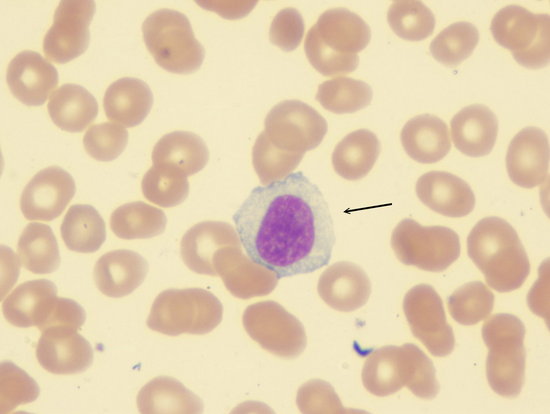 |
 |
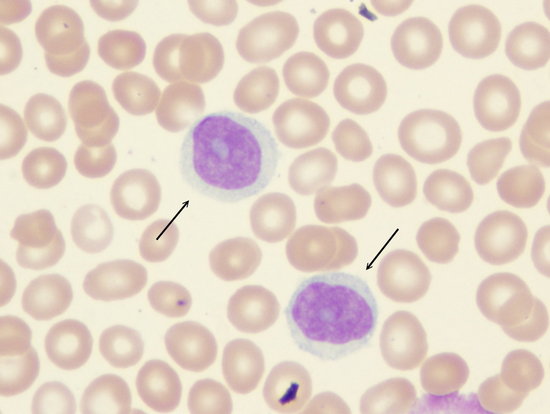 |
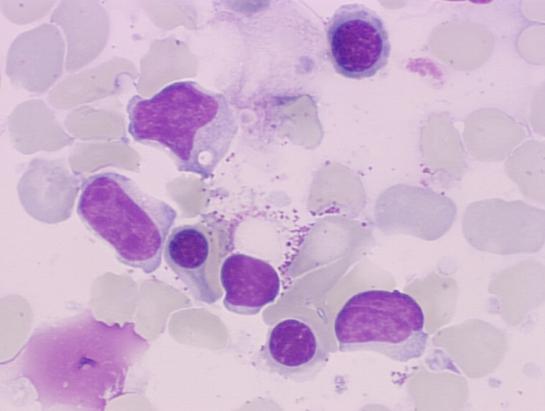 |
| Example morphology of MZL. | Example cytoprep and H & E slide of MZL |
Immunophenotyping
Initially the CD45 vs SSC gating dot plot is used to identify the different cell populations. Relative proportions are within the normal range, but phenotypic information will show otherwise.
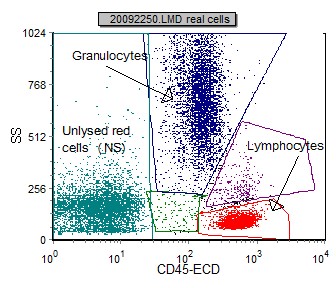 |
| The CD45 vs SSC gating dot plot identifies a population of lymphocytes of normal proportion. The light blue cells are unlysed rbcs and will be ignored. |
The following are selected gated dual parameter dot plots of the above case.
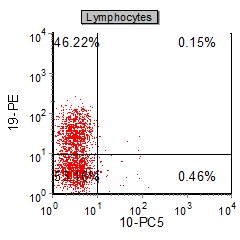 |
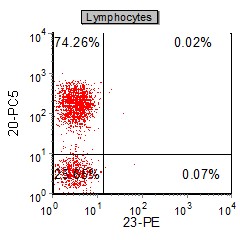 |
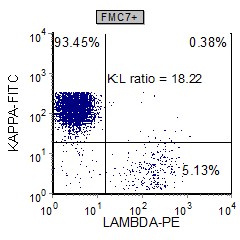 |
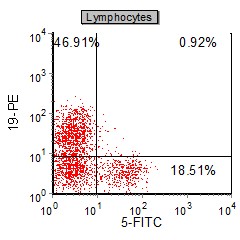 |
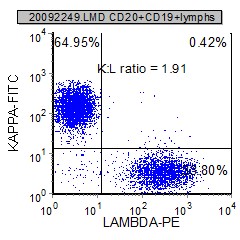 |
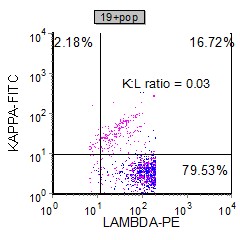 |
| In this case CD19 is expressed but CD10 is negative and CD5 is not coexpressed on the CD19 B cells. | CD20 is positive (brighter than CD19) and CD23 is not expressed. The kappa:lambda ratio is normal for the entire B cell population. | Upon further investigation, 2 populations are present; those cells expressing FMC7 and those expressing CD19. Each subpopualtion expresses a different light chain restriction. |
The immunophenotypes of nodal marginal zone lymphoma and extranodal marginal zone lymphoma are similar and distinguishable from other small lymphocytic lymphomas. The lymphoma cells in MALT and nodal marginal zone lymphoma are mature B cells, with intense surface membrane Ig, IgM greater than IgG, whereas splenic zone lymphoma is typically IgD positive. The B cell-associated antigen profiles are similar in the three entities: a CD19+CD20+CD22+CD5–CD10–CD23–CD11c– phenotype.
| Antigen | Status in MZL |
| CD20 | Positive |
| CD79a | Positive |
| CD5 | Negative |
| CD10 | Negative |
| CD23 | Negative |
| CD43 | Negative |
| cyclin D1 | Negative |
Other relevant tests
Genetics: Clonal rearrangements of the immunoglobulin genes (heavy and light chains) are frequently seen. The deletion 7q21-32 is seen in 40% of SMZL patients, and translocations of the CDK6 gene located at 7q21 have also been reported.
Sub-classification
The clinicopathologic entities include (1) extranodal marginal zone MALT lymphoma, (2) nodal marginal zone lymphoma, and (3) splenic marginal zone lymphoma.
Flow Diagnosis
The relevant markers that define the immunophenotype for SMZL are shown in the table to the right. The lack of CD5 expression is helpful in the discrimination between SMZL and chronic lymphocytic leukemia/small lymphocytic lymphoma (CLL/SLL), and the lack of CD10 expression argues against follicular lymphoma (FL). Mantle cell lymphoma (MCL) is excluded due to the lack of CD5 and cyclin-D1 expression.
References
1. Armitage JO, Weisenburger DD. "New approach to classifying non-Hodgkin's lymphomas: clinical features of the major histologic subtypes. Non-Hodgkin's Lymphoma Classification Project." J Clin Oncol. 1998 Aug;16(8):2780-95. PMID: 9704731
2. Matutes E, Morilla R, Owusu-Ankomah K, Houlihan A, Catovsky D. "The immunophenotype of splenic lymphoma with villous lymphocytes and its relevance to the differential diagnosis with other B-cell disorders." Blood. 1994 Mar 15;83(6):1558-62. PMID: 8123845
3. Savilo E, Campo E, Mollejo M, Pinyol M, Piris MA, Zukerberg LR, Yang WI, Koelliker DD, Nguyen PL, Harris NL. "Absence of cyclin D1 protein expression in splenic marginal zone lymphoma." Mod Pathol. 1998 Jul;11(7):601-6. PMID: 9688179
